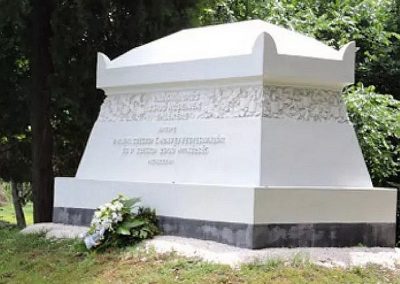He was born in Timisoara in 1874. He studied the technique of copper engraving with Alfred Wesemann in Vienna. He lived in Szeged, where he had a fully equipped copper engraving workshop. He also worked as a sculptor, mainly making tombstones.
He first exhibited at the National Salon in 1904, then participated in the 1909 graphic exhibition at Műcsarnok (Winter Landscape in Northern Hungary). In 1917 he exhibited a collection of graphics in St. George's Guild. The Museum of Fine Arts in Budapest (Szépművészeti Múzeum) holds some of his works.
He designed the ancient Jewish inscriptions and stylized the floral decorations of the Szeged synagogue.
In 1932 he published a book on the symbols used in Jewish tombstones, Grabstein Symbolik, the title in Hungarian, Jelképes siremlékek.
Ármin Tardos-Taussig was part of a group of plastic artists of social-democratic political orientation, who presented in 1919 a program of progressive development of fine arts (beaux arts) in Szeged. This initiative led - after the liquidation of the proletarian revolution - to the creation of the Free School of Art in Szeged (Szegedi Művészeti Szabadiskola).
Ármin Tardos-Taussig died in 1936 in Szeged.
In 1933 a monument in memory of the Jewish heroes who fell in the First World War was inaugurated in the Jewish cemetery in Szeged. The following note (in translation) appeared in the newspaper Délmagyarország (Southern Hungary) of October, 31 1933, pp. 5-6:
A monument to Jewish heroes was inaugurated by Lieutenant General Kálmán Shvoy during a military ceremony.
On Sunday, a clear blue sky overcast the city. The golden autumn sun illuminated the houses, plains, gardens and people who came smiling in this magical autumn sun. A work erected in memory of fallen Jewish heroes, designed by Ármin Tardos-Tauszig, was unveiled in the Jewish cemetery at 11 a.m. Hundreds and hundreds of people rushed to the cemetery early in the morning. Crowded cars and trams transported those wishing to be present, a long line of pedestrians gathered on Calea Calvarului and the whole crowd entered the cemetery guarded by police. On either side of the short road from the entrance to the monument, armed soldiers stood guard. The crowd was kept in order by the army and police. (translation: Aby Weiss)
In 2016, the monument was restored and reopened.
Sources:
- Magyar Zsidó Lexikon, Budapest, 1929
- Tardos-Taussig Ármin, Grabstein Symbolik. Traub B. és Társa, Szeged, 1932.
- Szelesi Zoltán: Les beaux-arts à Szeged.-(internet)
- Obermayer Ernö, Tardos-Taussig Ármin emlékezetére
http://digit.bibl.u-szeged.hu/00000/00099/01936/00051/dm_1936_053_012.pdf - Krisztina Frauhammer, Elfeledett arcok Szeged zsidó multjából
https://multesjovo.hu/en/kultur_cikk/frauhammer-krisztina-elfeledett-arcok-szeged-zsido-multjabol-1/
